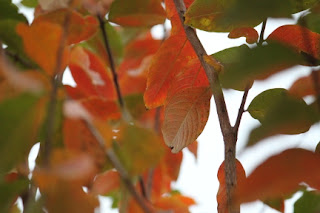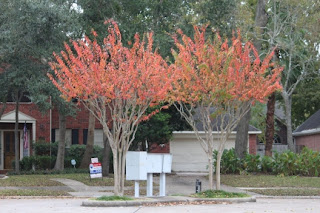 |
| Crape Myrtle leaf |
Last year, it seemed like the Bradford pear trees were unusually colorful. This year, it's the crape myrtles. All around my neighborhood, these lovely ornamental trees area covering themselves in shades of red and gold. Most of them, that is. My trees, '
Basham's Party Pink,' do not seem particularly lovely, perhaps when compared to the neighbors' trees.
 |
| Within yards of my nondescript trees. |
I'm not sure what variety of crape myrtles are planted in our common areas. They're a small to medium-statured tree with pinky-lilac flowers, perhaps
'Muskogee.' They're all in various stages of fall coloration and it's beautiful, especially on days like this when it's overcast.
 |
| They have a lovely, smooth bark, too! |
Crape myrtles were introduced (from Asia) in 1747, and are common throughout the southern US. We like to say they are "the lilic of the South," but having lived in northern climes, I have to disagree. Crape myrtles lack the scent, which seems to me to be the main thing about lilacs. But their bloom season is very, very long -- almost all summer.
 |
| Happy fall! |
And then, too, we occasionally get these wonderful autumn days when the crape myrtles form a blazing backdrop for a few bare branches. Enjoy!








They are a pretty pair!
ReplyDelete